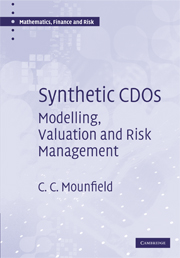Book contents
- Frontmatter
- Contents
- Preface
- Acknowledgements
- 1 A primer on collateralised debt obligations
- 2 Modelling of obligor default
- 3 Valuation of credit default swaps
- 4 Credit indices
- 5 Valuation of default baskets
- 6 Valuation of synthetic CDOs
- 7 Phenomenology of the standard market model
- 8 Risk quantification of synthetic CDOs
- 9 Implied and base correlations
- 10 Extensions of the standard market model
- 11 Exotic CDOs
- 12 Correlation trading of synthetic CDO tranches
- 13 Risk management of a portfolio of synthetic CDOs
- 14 Hedging simulation of structured credit products
- Appendix A Explanation of common notation
- Appendix B Simulated annealing
- References
- Index
4 - Credit indices
Published online by Cambridge University Press: 06 July 2010
- Frontmatter
- Contents
- Preface
- Acknowledgements
- 1 A primer on collateralised debt obligations
- 2 Modelling of obligor default
- 3 Valuation of credit default swaps
- 4 Credit indices
- 5 Valuation of default baskets
- 6 Valuation of synthetic CDOs
- 7 Phenomenology of the standard market model
- 8 Risk quantification of synthetic CDOs
- 9 Implied and base correlations
- 10 Extensions of the standard market model
- 11 Exotic CDOs
- 12 Correlation trading of synthetic CDO tranches
- 13 Risk management of a portfolio of synthetic CDOs
- 14 Hedging simulation of structured credit products
- Appendix A Explanation of common notation
- Appendix B Simulated annealing
- References
- Index
Summary
Introduction
In this chapter we introduce the credit indices. A credit index is a natural generalisation of an individual CDS to a portfolio of CDSs. Since their introduction around 2004 (in their current incarnation as iTraxx and CDX), they have become the most liquid of all credit derivative instruments.
As the single-name CDS market became more liquid and standardised (particularly in terms of documentation setting out standard terms and conditions) it became apparent that there was investor demand for increasingly sophisticated credit products which facilitated the trading of complex market views. The introduction of standardised indices in the same spirit as the indices which exist for equity and other markets, with transparent and stable construction and trading rules, provided an enormous impetus to the credit derivative market. Credit index products enable investors rapidly to take a macro view of the overall credit market and to trade accordingly (directional and relative value trades, leveraging credit investments and going long and short the market) – although this also introduces volatility (which can also be traded via index options). They have introduced a whole new dimension of trading and investment strategies for investors. Like single-name CDSs, index trades are traded in the privately negotiated OTC market. Liquidity was further enhanced by the introduction of tranched exposures to specific portions of the index's portfolio loss distribution (the index single-tranche synthetic CDO market).
- Type
- Chapter
- Information
- Synthetic CDOsModelling, Valuation and Risk Management, pp. 66 - 80Publisher: Cambridge University PressPrint publication year: 2008

